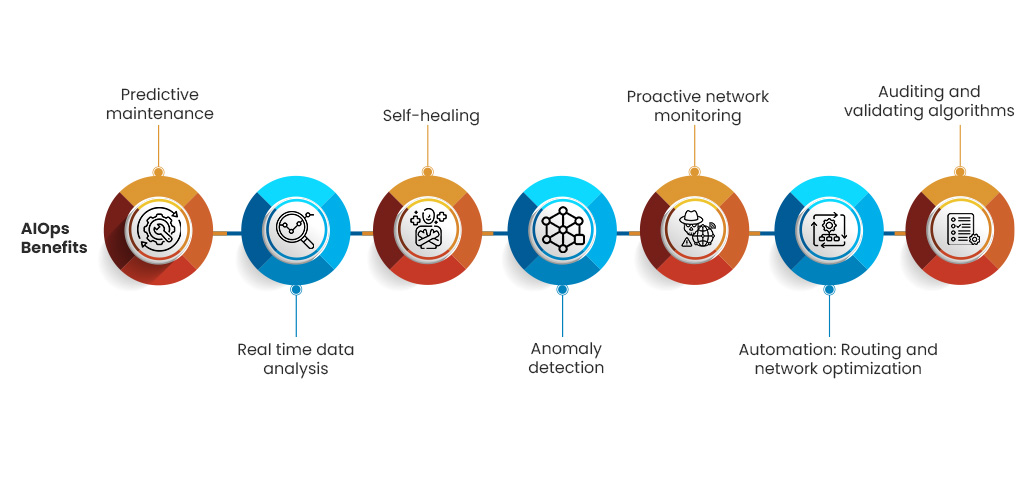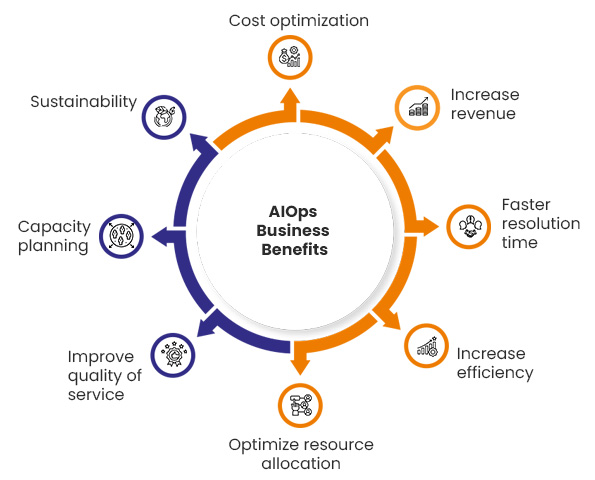


Sagar Nangare
Exploring AI’s Role in Telecom Networks Through Recent Developments
The world of technology is abuzz with the potential of Artificial Intelligence (AI), and the telecommunications industry is no exception. The emergence of “GenAI” – the practical application of AI for real-world scenarios – is fascinating for telecom operators. It promises to transform network management, optimize operations, and deliver a superior user experience.
Managing complex, multi-vendor networks spread across vast geographical regions is a constant challenge. Manual intervention is not only time-consuming but also expensive. Here’s where GenAI offers a glimmer of hope. AI can significantly reduce telecom companies’ operational costs by automating tasks and streamlining processes.
The pressure to constantly innovate and invest in new network infrastructure can be daunting for telecom operators. Every investment needs careful consideration to ensure a positive return. Fortunately, recent advancements like Fixed Wireless Access (FWA) and fiber broadband solutions, coupled with AI optimization, enable operators to tap into the booming digital media market and monetize their network improvements.
The recent Mobile World Congress (MWC) 2024 served as a testament to the growing importance of AI in telecom networks. “GenAI” was a central theme, with leading companies showcasing solutions that leverage AI to:
- Detect network anomalies proactively
- Identify emerging trends in network usage
- Automate network adjustments for optimal performance
This article focuses on the recent developments surrounding AI in telecom networks, specifically exploring collaborations between industry players, and highlighting success stories through reports and case studies. It aims to provide a clear picture of the current landscape, identify the frontrunners in AI adoption, and showcase the potential use cases to revolutionize the telecommunications industry.
AIOps Benefits
AIOps Business Benefits
Notable Case Studies
BT Business
The telecommunications landscape is brimming with companies offering AI-powered network solutions. However, BT Business stands as a prime example of how AI can revolutionize network management. By partnering with IBM, BT Business harnessed the power of AIOps and real-time performance monitoring. This collaboration yielded significant benefits:
- Enhanced Visibility: BT gained a comprehensive view of its diverse network infrastructure, enabling proactive problem identification and resolution.
- Streamlined Operations: By consolidating 80% of its monitoring systems, BT simplified integration and significantly reduced software licensing costs.
This successful implementation showcases AI’s transformative potential in network management. BT Business is a compelling case study for how AI can optimize operations, reduce costs, and ultimately, deliver a more robust network experience.
AT&T
AT&T, a major US broadband provider, partnered with H2O.ai to develop an AI-as-a-Service platform. This platform streamlined their AI operations, allowing them to move from small, open-source projects to large-scale AI implementation across the company. By utilizing AutoML and cloud-based solutions, AT&T significantly reduced development times and democratized AI access within the organization. This shift has led to substantial business value, including an 80% reduction in iPhone fraud, and demonstrates the power of AI platforms in transforming how companies work with artificial intelligence.
Recent Developments
- Orange collaborates with Augtera Network AI Platform: The French telecommunications giant Orange has joined forces with Augtera Networks to deploy an AI platform within its Network Operations Center (NOC). This partnership heralds a strategic pivot towards AI-driven network management in the telecom sector. This integration promises to enhance network efficiency and minimize network downtime.
- In March 2024, Orange Business made a significant leap forward in the generative AI (GenAI) landscape with two new offerings announced at the Orange Business Summit. This advancement positions them as a potential leader in the field, particularly for its focus on trusted and comprehensive GenAI solutions.
Orange Business caters to a broad spectrum of customer needs with its dual offering:
- This “ready-to-use” solution, developed in partnership with LightOn, offers a low-barrier entry point for businesses of all sizes. Focusing on pre-built functionalities for everyday tasks like document management and content generation allows rapid adoption.
- Orange Business differentiates itself with a “first-to-market” claim for its GPU-as-a-service offering, which meets the needs of enterprises requiring complete control over their GenAI infrastructure. Highly customizable hardware allows businesses to train and deploy complex, specialized large language models (LLMs) through partnerships of their choice.
- Swisscom and Ericsson have extended collaboration to create a “smart network” in Switzerland. This network will utilize automation, AI, and innovative technologies to enhance efficiency and elevate customer experience. Sustainability takes center stage in this partnership, with the network already powered by renewable energy sources. Additionally, a new initiative aims to curtail energy consumption further, reinforcing their commitment to environmental responsibility.
- Singtel partnered with NVIDIA to offer AI infrastructure services in their data centers. This collaboration aims to make AI technology more accessible (democratizing) for businesses, startups, and research institutions. With this collaboration, they’ll be able to leverage the power of AI sustainably within Singtel’s specialized AI data centers.
- Telecom giants SK Telecom (SKT) and Malaysian operator CelcomDigi join forces to bring AI-powered solutions to the metaverse. SKT’s ifLand platform will leverage CelcomDigi’s network technology and AI expertise to deliver innovative metaverse experiences and enhance customer value.
- NTT and OIST, a renowned research institute, collaborated to advance environmental science, quantum science, and brain/neuroscience research. Their shared objective was to pioneer technologies conducive to a sustainable society, fostering a harmonious balance between technology, human welfare, and the environment. Acknowledging the potential adverse effects of swift technological progress on the environment, they endeavored to comprehend natural phenomena and human well-being. They aimed to harness artificial intelligence (AI) to tackle environmental challenges and enhance overall welfare. This collaboration involved incorporating research insights into AI development, with the ultimate aspiration of leveraging AI to address societal concerns and forge a sustainable tomorrow.
- RADCOM and Rakuten Mobile have extended their partnership to include advanced AI features in Rakuten’s mobile network. This AI will help Rakuten proactively identify and prevent network issues, leading to better service quality, more efficient operations, and potentially even automated network monitoring.
- Elynza and KDDI join forces to accelerate the adoption of AI-powered applications (GenAI) in Japan. Elynza brings its expertise in developing large language models (LLMs), while KDDI contributes its vast computing infrastructure and network resources.
- KDDI revealed plans to bring GenAI technology to consumers by integrating its metaverse and Web3 service, known as αU (Alpha-U), with Google’s GenAI model Gemini Pro. The aim is to debut initial offerings utilizing this technology in the shopping and entertainment industries.
Reports on AI for Networks
CRM tools enhance customer service by providing a comprehensive view of customer interactions and enabling efficient issue resolution. Key functionalities include:
- Case Management: Track and resolve customer issues and inquiries.
- Knowledge Base: Provide self-service options with a searchable knowledge base.
- Omni-channel Support: Manage customer interactions across multiple channels (email, phone, chat, social media).
- Customer Feedback: Collect and analyze customer feedback to improve service quality.
NVIDIA State of AI in Telecommunications Report 2024
A recent NVIDIA survey of over 400 telecom professionals worldwide sheds light on the industry’s growing adoption of AI, particularly generative AI. The survey highlights a significant increase in executive-level enthusiasm for AI, with expectations of its success continuing to rise.
One key takeaway is the industry’s embrace of generative AI. This technology is a significant opportunity to enhance customer experiences, attracting the highest investment dollars. Additionally, AI is viewed as a driver for revenue growth and cost savings.
However, challenges remain. Scaling AI solutions from pilot projects to full deployment is a top concern. While hybrid hosting remains the preferred option, cloud hosting is gaining traction. To address these challenges, telcos, and solution vendors increasingly rely on partnerships to navigate AI adoption.
One significant hurdle identified in the survey is the need for more skilled professionals to implement and manage AI solutions, underscoring the necessity for increased training and development programs within the telecom industry to bridge this critical skill gap.
Omdia’s Enterprise AI Contracts Database
A new report by Omdia highlights a potential gold rush in Generative AI (GenAI). GenAI contracts saw a staggering increase, jumping from a mere 7% to a hefty 38% in just six months. The data translates to 96 massive contracts mentioning GenAI in 2023 alone. While these numbers suggest businesses actively embrace GenAI, there might be more.
The contracts themselves could be a double-edged sword. Vendors might use them to showcase their latest GenAI offerings, while companies could leverage them to project an image of cutting-edge innovation. Cloud service provider contracts hint at a wide range of potential GenAI applications. However, a scatter-shot approach could lead businesses to waste valuable resources on GenAI without clearly understanding their specific needs. Omdia’s data also sheds light on the sectors most interested in GenAI. The IT industry unsurprisingly takes the lead, followed by healthcare, business services, media, and retail. The top use cases identified are virtual assistants for customer service and intelligent automation for improved efficiency. Other promising applications include sports analytics, automated report generation, and personalized marketing campaigns.
While Omdia’s data points to a booming GenAI market, it also underscores the importance of strategic planning for businesses. Careful consideration of their GenAI needs will ensure they capitalize on this technology’s potential and avoid wasted resources.
Perspective from leaders
Telecom leaders at a recent AI Native Telco Summit hosted by TelecomTV discussed the potential of AI and ML to revolutionize operations and infrastructure management within the telecommunications industry.
Danielle Royston, CEO and founder of Telco DR and acting CEO Totogi, believes that the Public cloud is necessary for AI and MLOps to succeed. She argues that most of the Telco data is trapped in siloed on-premise vendor databases that are siloed and don’t talk to each other, making collecting and managing the massive amounts of data required for AI and ML models challenging. Public Cloud offers a solution by providing a centralized platform where all the data can be stored and accessed.
Beth Cohen, SDN Product strategist at Verizon, said that AIOps is critical to the future of Telcos. There are two flavors of AI Ops: one focuses on the operation side of things, specifically related to network performance and how the network is monitored and managed. Encompassing natural language processing and further automation of the operation side, it tackles various aspects of network management. The other and more exciting flavor is machine learning, which is applied to the network to create better self-healing and application-aware awareness. Beth believes AIOps do not necessarily need to be in the public Cloud. She said that the public Cloud is a platform at the end of the day, and where the data resides does not necessarily matter. Business decisions should be grounded in considerations of costs, management, and the overall cost of ownership.
Juan Manuel Caro Bernat, director of autonomous networks at Telefonica, said that AIOps is a perfect tool to streamline operations. AIOps can be used for predictive maintenance, anomaly detection, and automation. Telefonica uses AIOps across the lifecycle of the network and its operations. For example, they use AIOps to predict faults before they happen and to detect anomalies. However, AIOps is not a silver bullet, and it is essential to understand the data being used. Telefonica is working on improving the accuracy of their AIOps models and extending them to more parts of the network.
Benefits of AIOps discussed in the panel include:
- Improved automation and zero-touch operations
- Faster anomaly detection and resolution
- Improved network performance and quality of service
- More efficient use of resources
Challenges of implementing AIOps discussed in the panel include:
- Need for massive amounts of data
- Lack of a unified data model
- Cultural resistance to change
- Difficulty in interpreting and operationalizing AI insights
Conclusion
While challenges persist, the potential rewards are undeniable. Collaborative efforts between telecom operators, technology providers, and research institutions will be instrumental in overcoming these hurdles. As AI matures and becomes more accessible, the telecom industry is poised to witness a surge in innovation. These advancements, in turn, will empower users with unparalleled connectivity, propel the metaverse into the mainstream, and pave the way for a future where technology seamlessly integrates with environmental responsibility. The future of telecom is intelligent; it’s connected, and AI powers it.
Leverage the automation capabilities of CRM tools to streamline repetitive tasks. Automate workflows such as lead assignment, follow-up emails, and data entry to save time and reduce errors.
Related Insights

Semiconductors Leading the Charge in the Transition to 6G and Future Tech

Optimizing the Flow: How Software Manages Fiber Optic Networks

Protecting User Data in an Evolving Digital Landscape

Advancements in GenAI for Enhanced O&M and Computing Optimization



